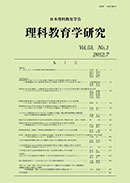
- Issue 3 Pages 1-
- Issue 2 Pages 1-
- Issue 1 Pages 1-
- |<
- <
- 1
- >
- >|
-
Takahiro KATO2000Volume 40Issue 3 Pages 1-11
Published: March 31, 2000
Released on J-STAGE: June 30, 2022
JOURNAL FREE ACCESSThe problem of elementary school students' "theory-laden observation" in science classes has been pointed out. However, the study of effective teaching strategies in regard to "theory-laden observation" as a characteristic of human cognition has rarely been done. In this study, I pay attention to the na_ve concept, a characteristic of elementary school students' cognition resulting from "theory-laden observation," and I examine the validity of "messing about" as a teaching strategy for changing such na_ve concepts which influence students' observations and experiments. We analyzed the students' responses and found the following two points: (1) In regard to changing students' na_ve concepts that influence their observations and experiments, "messing about" is an effective strategy of teaching. Especially activity of the ○ situation of "messing about" is important. (2) In order to develop students' awareness of and challenge and revise their na_ve concepts, teachers can have them proceed with quantitative experiments of free domtrials→△ of ○.
View full abstractDownload PDF (1655K) -
Hideo MUNECHIKA2000Volume 40Issue 3 Pages 13-22
Published: March 31, 2000
Released on J-STAGE: June 30, 2022
JOURNAL FREE ACCESSTo change students' understanding of solution to a scientific concept, what teaching methods and strategies are necessary? I tried to address this question theoretically through experimental teaching. First, to ascertain their understanding of solution, I surveyed 2,404 students, ranging from elementary school third graders to lower secondary school third graders (that is, from the third to the ninth grades) in Hiroshima prefecture. The teaching materials for the fifth grade of elementary school were used in the survey. The following are the results: 1. Without distinguishing whether a liquid is transparent or not, the students seemed to interpret the word "dissolve" according to their own judgment. In learning the scientific concept, it is important to emphasize transparency. 2. More than 50% of the students were able to form an image of particles, so in teaching the concept of particles, the introduction of the image of particles is possible, even at the elementary school level. 3. Neither the elementary nor the lower secondary school students had sufficient understanding of the uniformity of a solution or of saturation. If students have a poor understanding of solution, they will not be able to understand saturation. 4. At present, students are taught how to dissolve a solute in many ways in elementary and lower secondary schools, but as they go on to higher grades, the ways are restricted to heating, adding water, and stirring. 5. The students surveyed did not have a good understanding of the weight retention of a solute. Even at the lower secondary school stage, many believe that a solute loses weight when it is dissolved. 6. The students understood solution only superficially. For example, they misunderstood the weight retention of solutes like sugar, salt and powdered milk.
View full abstractDownload PDF (1289K) -
Yukio IKEDA2000Volume 40Issue 3 Pages 23-29
Published: March 31, 2000
Released on J-STAGE: June 30, 2022
JOURNAL FREE ACCESSIn this paper a new teaching evaluation method for science classes is developed and tested in practical cases. This method is based on the change in the student's image of a designated stimulant word (key word) before and after lessons. Such pre- and post-images have been investigated by using numerical scales such as the SD (Semantic Differential) method which presents several sets of adjectives with mutually opposite meanings. For numerical scales, we divide each set into five ranks from 1 to 5. Rank numbers 1 and 5 represent "very bad" or "strongly negative" and "very good" or "strongly positive" images respectively. And rank number 3 represents "neutral." We calculate the average values of difference (S) and its square (Ss) between post- and pre-images for each set of adjectives. Plotting all of the students' data on a graph whose horizontal and vertical axes represent Ss and S respectively, we can obtain a graphical representation of student responses to the lesson, which we call a CI-graph (Change of Image graph) in the present study. Based on theoretical considerations, we can divide the distribution patterns on the graphs into Types I, II, III, IV, and V, which reflect the various responses of the students. Therefore, we may conclude that these types give fairly objective standards for the evaluation of classroom teaching.
View full abstractDownload PDF (868K) -
Yasuo MATSUMORI2000Volume 40Issue 3 Pages 31-41
Published: March 31, 2000
Released on J-STAGE: June 30, 2022
JOURNAL FREE ACCESSThe present author tried 1) to create evaluation sheets using KOMETT Form, using propositions in relation to the cognitive domain of "Science" in the Course of Study for Elementary Schools in Japan (1998), 2) to analyze elementary school students' responses to these evaluation sheets, and 3) to compare four kinds of truth-value in the KOMETT Form with the truth-values which students use when they intend to answer the sheets. His findings include 1) that a total of 191 propositions could be made, 2) that about 98% of the students responded to all of the evaluation sheets, 3) that about 98% of them performed true-false judgments on the propositions, using either one or two kinds of truth-value from the four kinds of truth-value in the KOMETT Form, and 4) that KOMETT Form is a useful and applicable evaluation method in the cognitive domain for elementary school students who perform true-false judgments about such propositions.
View full abstractDownload PDF (1747K)
- |<
- <
- 1
- >
- >|